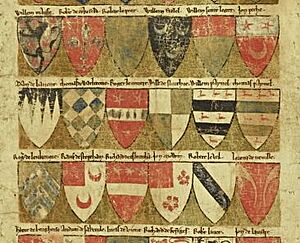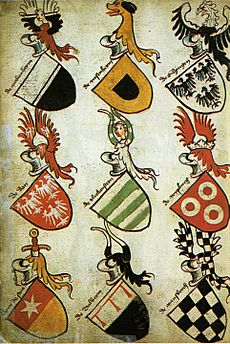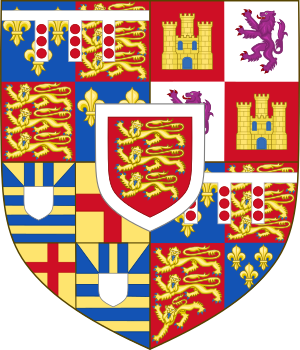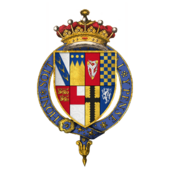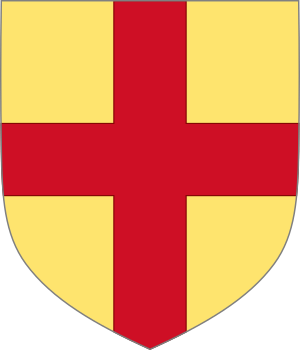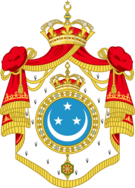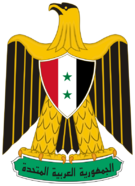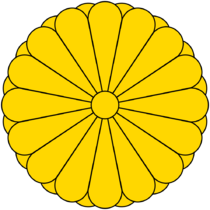Coat of arms facts for kids
A coat of arms is a special design, like a unique symbol, that people, families, or groups use. Think of it as a personal logo from long ago! These designs are often shown on a shield. They can also appear on clothing like a surcoat, which was a tunic worn over armor.
A full coat of arms, called a heraldic achievement, includes more than just the shield. It can have supporters (figures holding the shield), a crest (a design on top), and a motto (a short phrase). Each coat of arms is usually unique to its owner, whether it's a person, a family, a country, a school, or a company.
The name "coat of arms" comes from the medieval practice of wearing a cloth "surcoat" over armor. This surcoat had the wearer's special design on it. Over time, the term came to mean just the design itself. Collections of these designs are called rolls of arms. They helped people track noble families and their history for centuries.
Contents
The History of Coats of Arms
Coats of arms first became popular among important families in Europe around the 1100s. At first, these designs were personal. A nobleman might even change his design over time. But by the late 1100s, especially in England during the time of King Richard I, these designs started to be passed down from father to son. This made them hereditary.
Soon, not just noble families used coats of arms. By the 1300s, regular citizens in places like Northern Italy and the Holy Roman Empire also began using them. Later, churches, towns, universities, and even trading companies adopted their own unique designs. These symbols helped everyone know who was who.
The word "coat of arms" originally described a special tunic, or "surcoat," worn over armor. This surcoat had the family's design on it. It was especially useful in tournaments and battles to tell people apart. Over time, the term came to mean just the design itself.
Even though there wasn't one big rulebook for all of Europe, the way coats of arms were designed stayed pretty similar. Countries like England and Scotland still have special offices, like the College of Arms, that manage and approve new designs. These offices make sure each design is unique and follows old traditions.
Today, coats of arms are still important. Many cities, universities, and organizations use them as their official symbols. They are like a special trademark or logo that represents their history and identity.
How Different Countries Use Coats of Arms
Coats of arms developed differently in various parts of the world. Each region has its own unique style and rules for these special symbols.
French Heraldry: A Family's Symbol
In France, the system of heraldry influenced many other European countries. Today, coats of arms are seen as a family's intellectual property. This means a family can create and use its own design, as long as it doesn't copy an older one.
British Heraldry: Unique to Each Person
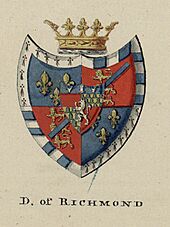
In England and Scotland, a coat of arms traditionally belongs to one person, not just a whole family. It passes from father to son. Wives and daughters can also use modified versions of these arms. Special rules, called "cadency," ensure that each family member's design is slightly different. This helps identify who is who. The College of Arms in England and the Lord Lyon King of Arms in Scotland are the official groups that manage these designs.
German and Nordic Heraldry: Bold Designs
German heraldry has a strong, distinct style. It often features repeating themes from the shield in the crest. This style greatly influenced the designs in Nordic countries like Norway, Sweden, and Denmark. In these countries, towns and regions proudly display their coats of arms on buildings and documents.
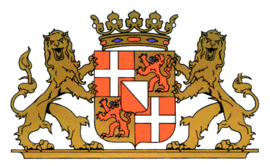
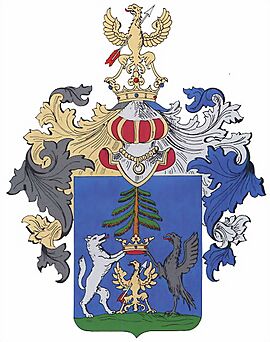
North American Heraldry: New Traditions
In North America, countries like Canada and the United States have also adopted heraldic traditions.
Canadian Heraldry
The monarch of Canada has given the Governor General of Canada the power to grant coats of arms. Canada has its own Chief Herald and Herald Chancellor. The Canadian Heraldic Authority is the government agency that creates and promotes Canadian heraldry. It is located at Rideau Hall.
United States Heraldry
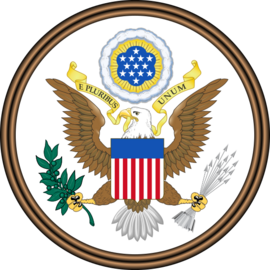
The Great Seal of the United States uses a heraldic design as its main symbol. It shows a shield with thirteen stripes on the chest of an American bald eagle. This seal was adopted in 1782. Many US states also have their own coats of arms, often as part of their state seals. These symbols represent the state's history and values.
Church Coats of Arms
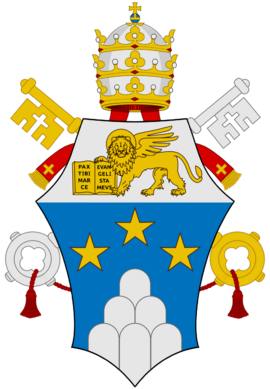
The Vatican City State and the Holy See both have their own coats of arms. Leaders of the Church, like the pope, also have personal coats of arms. Since the role of pope is not passed down through family, each pope chooses his own design. These designs often reflect his beliefs or important goals.
For example, Pope John Paul II's coat of arms included a large letter "M." This stood for the Virgin Mary and showed his strong devotion to her. Many Catholic areas, called dioceses, and important churches also have their own unique coats of arms. You can often see these symbols displayed on church buildings.
Flags and Heraldry: What's the Difference?
While flags and coats of arms both use colors and designs, they are usually different. Flags are used to identify things like ships or embassies. A country often has both a national flag and a national coat of arms. These two symbols might look very different from each other.
For example, the flag of Scotland is a white 'X' on a blue background. But the royal arms of Scotland shows a red lion on a gold background. Both are important symbols, but they serve different purposes.
Modern Country Symbols
Many countries today use national emblems that are like coats of arms. These symbols often tell a story about the country's past or its values.
After the fall of communist governments, some countries, like Russia, went back to using their older symbols. They often removed any signs of monarchy. Other countries, like Belarus, kept some parts of their communist-era designs.
In the Arab World, many countries adopted emblems that include symbols like the star and crescent or birds like the Eagle of Saladin. These symbols reflect important cultural and religious traditions in the region.
African countries, after gaining independence, often chose emblems based on local traditions or wildlife. For example, the leopard appears in the arms of several nations like Benin and Malawi. Many also use mottos in their local languages, such as "Harambee" (Let us come together) in Kenya.
Symbols from Other Cultures
Other cultures around the world have their own unique systems of symbols, similar to European coats of arms. For example, in Japan, there are family badges called kamon (often shortened to "mon"). These symbols have been used for centuries and often feature abstract or floral designs.
See also
 In Spanish: Escudo (heráldica) para niños
In Spanish: Escudo (heráldica) para niños
- Armorial of UK universities
- Gallery of country coats of arms
- List of coats of arms
- National emblem
- Seal


